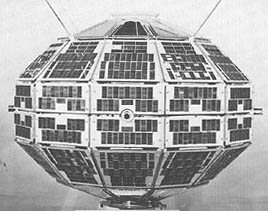Alouette 1
| Alouette 1 | |
|---|---|

|
|
| Type: | Research satellite |
| Country: |
|
| Operator: | CDRB |
| COSPAR-ID : | 1962-049A |
| Mission dates | |
| Dimensions: | 145 kg |
| Begin: | September 29, 1962, 06:05 UTC |
| Starting place: | Vandenberg AFB , SLC-2E |
| Launcher: | Thor-Agena B. |
| Status: | in orbit, out of order |
| Orbit data | |
| Rotation time : | 105.5 min |
| Orbit inclination : | 80.5 ° |
| Apogee height : | 1032 km |
| Perigee height : | 996 km |
| Eccentricity : | 0.002433 |
Alouette 1 was Canada's first satellite . It was launched into orbit in 1962 - five years after the USSR put the first Sputnik 1 satellite into orbit in 1957 and four years after the US launched Explorer 1 . This made Canada the third nation with a satellite in orbit. The name Alouette is derived from the French word for lark and the title of a popular French-Canadian folk song .
Start and mission progress
Alouette 1 was developed in collaboration with NASA from Vandenberg Air Force Base in California on a Thor - launcher with an Agena brought upperstage on September 29, 1962 into space. Alouette's job was to study the ionosphere , an area of the upper atmosphere where many future satellites would also be placed. Alouette's mission lasted 10 years before the device was shut down on schedule. The mission director was the Canadian John Herbert Chapman.
In June 2010, Alouette 1 was still in orbit and some of those responsible at the time assumed that if the activation signal was sent out, there was little chance of it being reactivated.
Multiple construction
Two more satellites were built for redundancy in the event of a malfunction; if the first satellite were to fail, the second could be launched just a few months later. It took 3½ years from the proposal for Alouette to its development and construction. The mechanical frame was made in Downsview by the Canadian manufacturer de Havilland Canada , this building is now the Toronto Aerospace Museum . The satellites S27-2 (prototype), S27-3 (the deployed satellite) and S27-4 (backup) were assembled by the Defense Telecommunications Establishment Electronics Lab in Ottawa. The batteries used for Alouette were developed by a division of the Canadian Defense Research Board and were responsible for the long life of the satellite. The antennas used were two 45.7 m and 22.8 m long dipole antennas . After completion Alouette weighed 145.7 kg and was of a two-stage Thor Agena-B - missile launched. Alouette 1's backup satellite was launched in 1965 as Alouette 2 to replace the older Alouette 1.
Web links
- Alouette 1 in the NSSDCA Master Catalog (English)
- Canada Connects: Alouette 1 - The Project that Launched the Canadian Space Industry
- CBC Digital Archives: Launching the Digital Age: Canadian Satellites
Individual evidence
- ↑ Canada Connects: ALOUETTE 1 - The Project that Launched the Canadian Space Industry ( Memento October 10, 2006 in the Internet Archive )
- ↑ Alouette 1 in the NSSDCA Master Catalog (English)